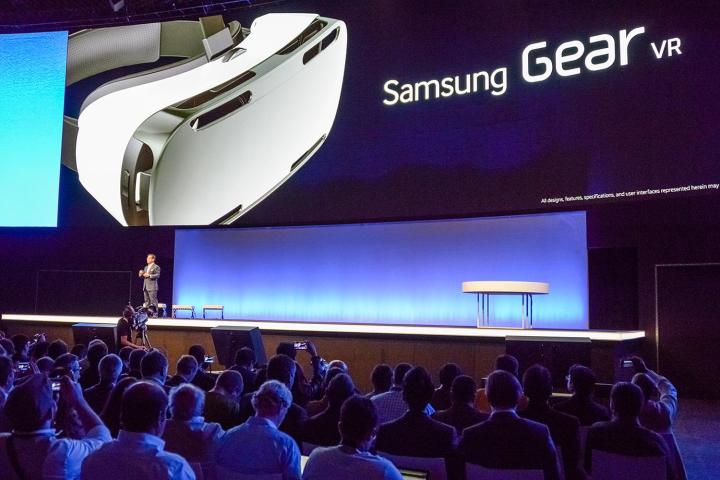
Enter Samsung’s Gear VR. The product of a partnership with virtual reality standard-bearer Oculus VR, Gear VR marries mobile hardware with a completely untethered headset. Oculus Rift and Sony’s PlayStation-focused Project Morpheus link up to computing hardware via long wires, but for the Samsung device, you simply slot your Galaxy Note 4 into the headset’s special housing. Virtual reality unleashed, as it were.
Consumer-ready virtual reality is here, but with an asterisk.
Consumer-ready virtual reality is here, but with an asterisk.
That leaves some very important questions unanswered, all of which revolve around the central head-scratcher that any potential VR user is going to have to consider: What kind of experience can I expect to get here? Here are the big three that will decide whether the Gear VR belongs on your wishlist this holiday season.
1. How long will this thing run?
We’ve yet to get a sense of how gaming might work on a Gear VR (more on this in a bit), but a non-interactive experience like Oculus Cinema — essentially a virtual theater — could keep a user immersed for an entire feature-length film. We have to wonder what two to three hours of uninterrupted Gear VR use would do to the Note 4’s battery.
- 2. Samsung’s Gear is a portable headset based on the Rift
Related: Oculus VR explored support for mobile devices in the upcoming consumer model
The Gear VR doesn’t appear to do any processing on its own; think of it more as an external display that the Note 4 plugs into. But even with minimal power needs on the headset side, it’s fair to speculate that connecting the Note 4 to a Gear VR is going to have some impact on battery life. Samsung touts the Galaxy Note 4 as improving on the Note 3’s battery life by 7 percent, but how that impacts playable time in a graphically intense game or 3D movie remains to be seen.
2. What will the virtual-reality experience feel like?
The Gear VR has its own built-in gyroscope and accelerometer to enable head-tracking — one of the most basic necessities of virtual reality. Even the very first virtual reality rigs of the ’90s allowed you to peer around the virtual space simply by moving your head.
Even the very first virtual reality rigs of the ’90s allowed you to peer around the virtual space simply by moving your head.
Related: Forget 3D movies; one director is taking on the challenge of developing a VR movie
This is, by far, the Gear VR’s most significant limitation as far as keeping pace with still-developing virtual reality experiences: It’s based on “last-gen” tech. Since it’s untethered and relies entirely on hardware mounted inside the headset, there’s no external solution for tracking the user’s movements beyond basic head tracking.
Is that a major problem? No. But it does limit what a virtual reality experience can feel like inside the Gear VR. This is especially true when you remember that the Galaxy Note 4 at the heart of Gear VR is nowhere near as powerful as a PlayStation 4 or most PCs that a Morpheus or Rift would connect to.
3. How are games going to work with this thing?
The popularity of the Rift and Morpheus both have made it clear that early adopters are more often than not going to be gamers. And with those two headsets, gaming is easy: Plug the headset into a console or PC, grab a controller, and start playing.
This is where, once again, Gear VR seems to lag a step behind. How will a controller work when there’s no external machine to plug it into? There isn’t any port on the headset to allow for such a connection. You only have a basic touchpad and a back button for making simple, tap-based selections.

Related: The next step for Oculus VR? Recruiting an army of 3D world-builders
In fairness, this is the easiest of our questions to answer. The peripheral market is flooded with Bluetooth-enabled controllers designed specifically for mobile devices, and there’s no reason why one of those couldn’t be used with a Gear VR game in the same way that Oculus currently has players controlling the action in EVE Valkyrie with an Xbox 360 controller.
We’re really asking this question because interface concerns went completely unmentioned in the Gear VR announcement. It was a conspicuous absence, and one that was very likely motivated by the standard PR tactic of getting the top-level information out about a new product before diving into specifics. It’s something we need to hear more about though, and soon. Gear VR is expected to arrive sometime before the end of 2014, and it’s going to be a hard investment to make until there’s a better sense of how an experience more involved than watching movies would work.
A final word
As exciting as Gear VR is — the first true consumer virtual reality product is mere months, possibly even weeks, away! — that asterisk is impossible to ignore. Strip away all the post-reveal hype, and you’re left with a consumer-ready virtual reality helmet that’s underpowered in relation to the tech’s 2014 improvements. Take Samsung’s “for developers and early adopters” caveat seriously. There’s little doubt that the tech will deliver on the company’s promises, but as with Morpheus and Rift both, it’s still very much a novelty act.






